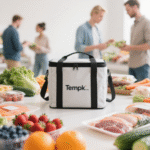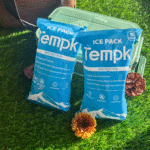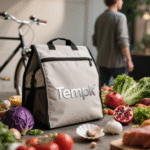Isolierte Kaltversandbox mit Anleitung für Trockeneisbeutel
If you need frozen integrity end‑to‑end, ein insulated cold shipping box with dry ice pack can hold −78.5 °C for 48–120 hours when you size refrigerant correctly, pack to vent CO₂, and label to 2025 PI954. You’ll get exact rules, a quick estimator, and a validated workflow you can copy today.
-
How much dry ice do you really need? Practical rule‑of‑thumb + physics check for 24–120 h lanes (UN1845 air freight included).
-
Is your labeling 2025‑compliant? PI954 Checkliste (200 kg/package cap), AWB wording, and where to place the Class 9 Etikett.
-
Packout that passes audits. A 7‑step SOP, plus hybrid PCM ideas for fragile payloads and weekend risks.
-
Validation that scales. Using ISTA 7D / ISO 23412 so one pilot run can justify your standard packouts.
-
2025 trends to watch. EU empty‑space limits, PFAS packaging rules, and smarter monitoring that cut waste and delays.
How much dry ice does an insulated cold shipping box with dry ice pack need?
Kurze Antwort: Plan 5–10 lb (2.3–4,5 kg) of dry ice per 24 h in a well‑insulated shipper; then add 20–40% for hot ramps or flights. This aligns with carrier guidance and works across most lanes; always validate on your route. UPS
Warum funktioniert es: Dry ice is “cold fuel.” As it turns to CO₂ gas, it absorbs ~571 KJ/kg—far more than water ice—so a small mass provides long holds. Lower air pressure at altitude and hot ambients increase sublimation, so air moves need a safety margin.
Dry ice estimator for frozen shipments (48–72H)
Quick start:
-
For a 48 h lane, begin at 0.3–0.5 kg per liter of payload space, then adjust for ambient and transport mode.
-
Physics check:
Dry ice (kg) ≈ (Heat leak (W) × hours × 3.6) / 571→ multiply by 1.2–1.5 for risk buffer. -
Validate with one lane test and a logger before you scale the SOP.
| Lane Scenario | Starting Mass | Adjustment Factor | What It Means for You |
|---|---|---|---|
| 48 H, mild 20–25 °C | 5 kg | × 1.0 | Good for domestic ground + early delivery |
| 72 H, summer 30–35 °C | 7.5–10 kg | × 1.2–1.4 | Up‑ice for hot ramps and delays |
| Luft + letzte Meile | As above | × 1.2 | Lower pressure increases sublimation; add buffer FAA |
Practical tips you can apply now
-
Position ice on top/around, never touching primaries. Cold CO₂ descends over the load.
-
Fill dead space. Less air = slower heat gain = longer holds.
-
Pre‑condition the liner 15–30 min with a small dry ice charge to reduce early losses.
Real -World -Fall: A 10 L diagnostic payload in a 35 L shipper with 8 kg Trockeneis stayed below −60 °C for 60 H Im Sommer, bestätigt durch einen USB -Logger.
Is your insulated cold shipping box with dry ice pack compliant with IATA PI 954 (2025)?
Essential checklist (Luft): UN1845 richtiger Versandname („Kohlendioxid, fest "oder" Trockeneis "), Netto -Kg Trockeneis, vented packaging per PI954, Klasse 9 Hazard -Etikett, Und ≤ 200 kg dry ice per package. Operator variations may be stricter.
Marking must match the AWB. If the AWB shows 8 kg, each package must be marked 8 kg and vented so CO₂ can escape—never airtight.
Copy‑ready AWB / label text (paste into your TMS)
Etikettenplatzierung: Put the Klasse 9 label on the same face as UN1845 + richtiger Versandname + Netz kg for clean acceptance.
| Item | Where It Goes | Warum ist es wichtig |
|---|---|---|
| "UN1845" + richtiger Versandname + Netz kg | On package (one panel) | Erforderlich von iata; prevents counter rejections |
| Klasse 9 Etikett | Same face as marks | Harmonized checks speed acceptance |
| Vent path (undicht) | Lid or vent plug | Avoids pressure build‑up and ruptures |
How do you pack an insulated cold shipping box with dry ice pack step‑by‑step?
Kernsequenz (7 steps):
-
Voraussetzung the liner 15–30 min.
-
Bag and seal primaries; add absorbent if needed.
-
Add a liner/tray so dry ice never touches primaries.
-
Place dry ice above/around die Nutzlast; surround on all sides for longer holds.
-
Hohlräume füllen with ice/dunnage.
-
Schließen Sie mit einem belüfteten Deckel; Niemals luftdicht.
-
Markieren & Etikett (UN1845, Eigenname, Netz kg) and update AWB.
Sicherheit zuerst: Use cryogenic gloves and eye protection; handle and open in ventilated areas; let leftovers sublimate in open air.
Hybrid strategies for fragile goods (PCM + Trockeneis)
Use a thin −20 °C PCM shell around the payload, then pack dry ice around the PCM. Das smooths cold shock, oft reduces dry ice by 10–20% on moderate lanes, and buys time if re‑icing is delayed.
| Kältemittel | Typisches Ziel | Dauerfenster | Why You’d Choose It |
|---|---|---|---|
| Trockeneis (CO₂ solid) | ≤ −78.5 °C | 24–120 h (load‑dependent) | Deep‑frozen biotech and robust frozen foods |
| PCM –21 ° C. | ~ −21 °C | 24–72H | Where dry ice is restricted or to buffer cold shock |
| Gel packs 2–8 °C | 2–8 ° C | 24–96H | Impfungen, Molkerei, meal kits—no freeze risk |
Field‑tested tips
-
Laden Sie das Eis von oben so cold gas blankets the payload.
-
Never seal vents. Lower pressure in flight accelerates sublimation—give CO₂ a path out. FAA
-
Photo the label face before handoff to catch Class 9 / UN1845 misplacement early.
How do you validate an insulated cold shipping box with dry ice pack (ISTA 7D / ISO23412)?
What to prove: Payload stays below your limit for the full duration with no probe excursions under summer and winter profiles, and recorded dry‑ice usage supports your re‑ice thresholds.
How to run it: Testen Sie drei Packouts (Grundlinie, −20% ice, +20% Eis). Log headspace and core probes under ISTA 7D profiles; document with photos and raw logger files. Verwenden ISO23412 to frame service requirements for parcel delivery networks. International Safe Transit AssociationISO
Bonus: Many teams are moving to ISTA STD‑7E profiles to mirror real parcel lanes more closely in 2025.
Trockeneis vs. Gel vs. PCM—what fits your insulated cold shipping box with dry ice pack?
Simple rule: Verwenden Trockeneis when anything must stay frozen solid or below −20 °C for days. Wählen PCM/Gel für 2–8°C, for items harmed by freezing, or when recipients can’t handle dry ice safely. Hybrid (PCM inner, dry ice outer) reduces risk and ice mass.
2025 trends and developments for insulated cold shipping box with dry ice pack
Was ist neu in diesem Jahr: EU PPWR brings 50% empty‑space limits for grouped/transport/e‑commerce packaging and reduction targets (5% von 2030; 10% von 2035; 15% von 2040)—pressuring oversized shippers and rewarding right‑sizing. USP <1079.2> activity keeps MKT‑based, risk‑led planning on auditors’ checklists. Expect broader ISO23412 adoption in parcel networks.
Neueste Fortschritte auf einen Blick
-
PI 954 acceptance is harmonized. Verwenden Sie das 2025 IATA acceptance checklist to mirror the counter check and avoid delays. Iata
-
Operator job‑aids are stricter on label placement. Align Class 9 with UN1845 text and net kg on the same panel.
-
PFAS in food packaging is tightening at the state level—expect buyers to favor fiber‑based liners and VIP reusables over PFAS‑treated foams.
Market insight: Packaging rules like California SB 54 keep pushing design toward recyclable materials and producer responsibility—another reason to reduce empty space and standardize sizes.
FAQ
How long will an insulated cold shipping box with dry ice pack keep items frozen?
With quality insulation, 5–10 Pfund pro Tag of dry ice usually holds 24–72H. Add 20–40% for summer or flights, and validate on your lane with a logger. UPS
What’s the maximum dry ice per package by air under PI 954?
200 kg pro Paket on both passenger and cargo aircraft—always check operator variations.
Do I need a Shipper’s Declaration if it’s only dry ice + non‑DG goods?
Typischerweise NEIN; folgen PI954 marks/labels and put UN1845 + Netz kg Auf der AWB. Use the IATA acceptance checklist to self‑audit.
Is it safe to seal the box tightly to slow sublimation?
NEIN. Never make it airtight. Trockeneis muss entlüften; pressure can build and damage packaging.
Which safety steps matter most when handling dry ice?
Verwenden cryogenic gloves/eye protection, arbeiten in belüftet Bereiche, Und let leftovers sublimate in open air.
Zusammenfassung & Empfehlungen
Key Takeaways: Größe Ihre insulated cold shipping box with dry ice pack using the 5–10 lb/day rule, add margin for flights/heat, und validieren mit ISTA 7D/7E. Für Luft, folgen PI954 to the letter: Entlüftungsverpackung, UN1845, Eigenname, Netz kg, Klasse 9 Etikett, ≤ 200 kg/package. Consider PCM buffers to smooth cold shock and cut ice mass.
Nächste Schritte (copy this plan):
-
Right‑size your shipper to reduce empty space and ice use.
-
Estimate ice with the quick calculator, Dann +20–40% for flights or heat.
-
Pilot one lane mit einem Logger; lock SOP and labels.
-
Train handlers on PPE/ventilation; add a receiving note for safe disposal.
-
Vierteljährlich überprüfen against PPWR/USP updates and adjust packouts.
Über Tempk
We’re cold‑chain specialists focused on insulated boxes, dry‑ice packouts, and PCM solutions for food, Biotech, and diagnostics. Our engineers map live lanes and validate against ISTA 7D/7E Und ISO23412 so your SOPs work on day one. Two concrete advantages: lane‑specific packouts that reduce ice mass and acceptance‑proof labeling that cuts refusals.
CTA: Want a lane‑ready dry ice sizing chart and a copy‑ready packout SOP? Sprechen Sie mit einem Tempk -Ingenieur Heute.
























